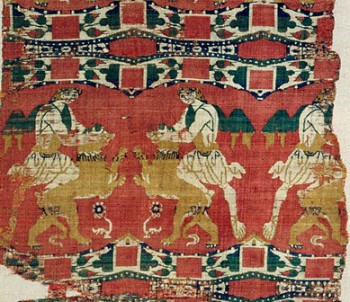The creation of textiles was among the most important of the arts in medieval Muslim society. The production of dyes, fibres, and other materials needed to weave textiles was the heavy industry of medieval times similar to the modern industries of steel and iron.
Different regions produced different fibres and fabrics. Linen was produced in the Nile Delta, while cotton was woven in Mesopotamia, Iran, and India. Silk, the most expensive fibre, was produced in pre-Islamic times when the technique was brought from China to Iran and Syria.
Many words for textiles have passed from Arabic and Persian into European languages; some terms have been derived from the site where a specific fabric was thought to have been woven. Thus, damask derives from Damascus, the capital of Syria; muslin from Mosul, a city on the upper Euphrates. Other textile terms are modifications: for example, mohair comes from the Arabic word mukhayyir meaning choice, and taffeta is from the Persian word taftan, to spin.

Textiles served various functions: they were used for clothing as well as for furnishings such as floor coverings, curtains, sacks, pillows, and spreads. Royal garments were inscribed with the caliph’s name and came to be known as tiraz – from the Persian tirazidan, to embroider. The term later came to describe a line of embroidered or woven inscription, and then the weaving institution itself.
Robes were also often inscribed with Arabic texts offering good wishes and blessings (barakat) to the rulers, and the names of the places of production as well as the dates they were produced. Many robes were cut up and the inscribed parts saved due to their perceived talismanic properties. The tiraz of the ninth century have short texts, while those of the tenth century onwards have elaborately decorated letters and longer titles, indicating the prestige of the rulers.
In medieval Muslim regions, the manufacture of textiles was one of the principal luxury industries; these textiles were immensely valuable not only in Muslim regions but also across the globe.

Textiles were also important to understand the history of art. Until large sheets of paper to make patterns became readily available in the fourteenth century, motifs and designs were often circulated through textiles, as they were readily portable and easily transported over vast distances particularly along the Silk Road. The mechanical weaving on a loom also encouraged the use of symmetrical, repeating, and geometric designs that characterise much of Islamic art.
Textiles of the Safavid period (Safavids reigned Persia from 1502 to 1732) drew from the art of book illustration and illumination as a pattern source. In the sixteenth century, Persia took the lead in artistic styles of book covers and bindings, initiating a glorious period for Persian book crafts.

Ottoman textiles, considered among the most prized luxury objects, are characterised by large-scale motifs often highlighted by shimmering metallic threads, were produced for domestic consumption as well as for export to Europe.

Textiles were produced in both caliphal and state-run factories. By the eighteenth century, the textile industry reached unprecedented heights of technical excellence.
Sources:
Textiles Close Up, Royal Ontario Museum
Nazanin Hedayat Munroe, Early Islamic Textiles: Inscribed Garments, The Met Museum
Esin Atil, “The Arts of Islam,” The Muslim Almanac Edited by Azim A. Nanji, Gale Research Inc. 1998
Compiled by Nimira Dewji